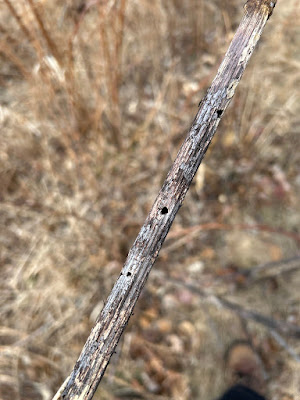Winter Stems and Insects
Plants have always been the things in nature that I am most drawn to. Recently I've been really exploring and learning a lot more about insects and lichens, but plants are still my main interest. As I learn more and more about ecology, insects get more and more of my attention. They have so many fascinating natural histories and ecological interactions. About 90% of all plant-feeding insects are specialists, only able to consume closely related plants, usually those of a certain genus or family. Many of the insects that consume other insects (especially parasitoids/parasites) are also specialists. So, to study and focus on insects, one must also study and focus on plants.
I've been thinking about these interactions between insects, plants, and the rest of the ecosystem quite a bit lately. Especially as I've come across quite a few parsnip webworm moths (Depressaria radiella). This species is native to Europe and introduced in the U.S. Here, I've only ever seen it associated with the native cow parsnip (Heracleum maximum), but would assume that it eats other things in the carrot family. The caterpillar feeds externally on the plant, then eats a hole in the stem where it will pupate and go through diapause in the winter, before emerging as an adult in the spring.
As I was walking at the Superior Site I first noticed these holes in a few of the stems of cow parsnip. I cut one open and saw a bunch of pupa. I assumed it was this species, but wasn't 100% confident because most pupa look pretty identical. After cutting a few more stems open, I found some of the larva and was able to confirm it was indeed this species. Interestingly all of the larva I saw were dead, with what looks like exit holes from parasitoids. After doing some research, it seems like the chalcid wasp Copidosoma sosares is the most likely candidate, but it could probably be a range of things that is parasitizing these larva. I also saw some midges in some of the stems with parasitized larva, so maybe that was the culprit. But, I think that they probably entered the stem through the hole and were just using it as shelter, but who could say.
It's amazing all the complex interactions that insects have between each other and plants. Plants are the base of the food web, but it is insects (especially moths) that transfer most of this energy up the food web to other organisms. So, moths and other insects also are an integral part of ecosystems and an important food source for birds, mammals, reptiles... Even animals that we usually don't think of as insectivorous can have them be very substantial parts of their diets at certain parts of the year. However, I'd guess that the parsnip webworm isn't a species that is directly super critical to the food web. Firstly it is non-native, and more importantly it eats on plants that have very strong chemical defenses. Cow parsnips have high concentrations of furanocoumarins which can give humans dermatitis if they get the sap on them. I'd assume that these moths bioaccumulate those toxins and use it as a defense, similar to what monarchs and so many other species do.
As I was researching this species I came across this article explaining how these moths, although not native, increase the number and diversity of arthropod species that interact with cow parsnip, mainly by making the stem more accessible to other species that can now enter do to the hole the webworms eat. That's what I'm guessing those midges were doing. Again, the ways that insects influence each other, plants, and other aspects of the ecosystem is so cool and complex!
Recently I've been doing a lot of reading about the interactions between plants, insects, and the rest of the ecosystem and the importance of conserving, restoring, and creating more native plant communities. Doug Tallamy has a lot of super fascinating work on this topic. So often in our human-built landscapes we choose to plant non-native species that do not contribute to the food web in any significant way. Furthermore we rake up all our leaves, cut all the dead stems, and simply over manage the landscape to look clean and well-kept. But, this is destroying these important food webs by killing all of the insects overwintering.
Seeing and reading about all of these parsnip webworms and associated insects really got me thinking about the importance of stems for overwintering insects. There is a great diversity of arthropods that rely on stems to complete their life cycle; moths, gall wasps, gall midges, bees, beetles, spiders... They also have a diverse set if niches; gall makers, bark miners, wood miners, borers, sap suckers, cavity nesters... I really kept an eye out for some of them this past week or so. Luckily, I have so many unkempt wild spaces near me and could find quite a few. But, how many of these would I see in an urban setting? By just slightly changing the way that we landscape and garden, we'd probably find a lot more. Here's just a sampling of some of the stem-dwelling insects that I've seen recently. Now, think of all the other parts of the plants that insects use: flowers, buds, leaves, roots... all which support their own host of arthropods.
























Comments
Post a Comment